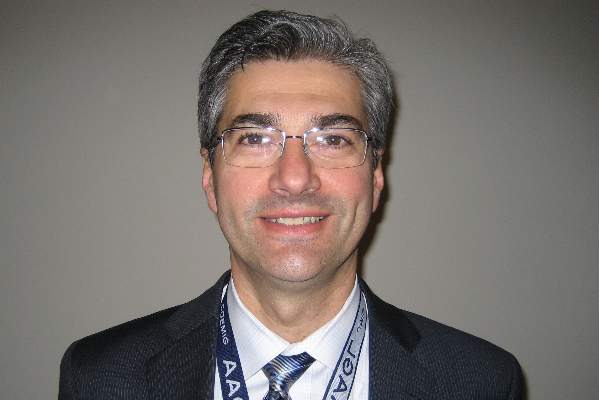User login
VANCOUVER, B.C. – The media played a major role in determining the fate of uterine morcellation, suggested a study reported at a meeting sponsored by AAGL.
“How did we lose this battle of uterine morcellation? We lost it in the media,” asserted lead investigator Dr. Adrian C. Balica, director of the minimally invasive gynecologic surgery program at the Robert Wood Johnson Medical School in New Brunswick, N.J.
He and his colleagues used the Google Adwords Keyword Planner to collect Internet search data for a variety of relevant terms used in 2013 and in 2014 through August.
This interval spanned events that included the first report of the issue in the mainstream media (December 2013), the Food and Drug Administration’s initial statement discouraging use of power morcellation for uterine fibroids (April 2014), and the issuance of analyses and rebuttals by several medical professional associations (May 2104 and thereafter).
Subsequent to the AAGL meeting, the FDA issued a new warning on Nov. 24, 2014, not to use power morcellation in the majority of women undergoing hysterectomy or myomectomy for uterine fibroids because “there is no reliable method for predicting whether a woman with fibroids may have a uterine sarcoma” that morcellation could spread. The agency estimated that about 1 in 350 fibroid patients actually have an occult sarcoma.
Results showed that the average monthly number of Google searches for the term “morcellation” held steady throughout most of 2013 at about 250 per month, reported Dr. Balica. There was, however, a sharp uptick in December 2013 to more than 2,000 per month, and the number continued to rise to a peak of about 18,000 per month in July 2014. A similar pattern was seen for the terms “morcellator,” “fibroids in uterus,” and “morcellation of uterine fibroid.”
Additionally, there were virtually no searches for “power morcellation” in 2013, but there were about 1,900 per month at the peak in April 2014. Much the same pattern was seen for “power morcellator,” he said.
Dr. Balica noted that the rapid cascade of events set into motion has had a profound impact for the field, including banning of morcellation at many hospitals and Johnson & Johnson withdrawing its power morcellator, which accounted for an estimated 72% of the devices used, from the market.
“Medical and surgical practice is going to be changed by the media,” he predicted. Thus, studying how the morcellator controversy unfolded in this venue can help inform strategies for addressing public perceptions.
His own hospital has stopped using power morcellation, according to Dr. Balica. “This is just the battle. Hopefully, we aren’t going to lose the war,” he concluded.
Dr. Balica disclosed that he had no relevant conflicts of interest.
VANCOUVER, B.C. – The media played a major role in determining the fate of uterine morcellation, suggested a study reported at a meeting sponsored by AAGL.
“How did we lose this battle of uterine morcellation? We lost it in the media,” asserted lead investigator Dr. Adrian C. Balica, director of the minimally invasive gynecologic surgery program at the Robert Wood Johnson Medical School in New Brunswick, N.J.
He and his colleagues used the Google Adwords Keyword Planner to collect Internet search data for a variety of relevant terms used in 2013 and in 2014 through August.
This interval spanned events that included the first report of the issue in the mainstream media (December 2013), the Food and Drug Administration’s initial statement discouraging use of power morcellation for uterine fibroids (April 2014), and the issuance of analyses and rebuttals by several medical professional associations (May 2104 and thereafter).
Subsequent to the AAGL meeting, the FDA issued a new warning on Nov. 24, 2014, not to use power morcellation in the majority of women undergoing hysterectomy or myomectomy for uterine fibroids because “there is no reliable method for predicting whether a woman with fibroids may have a uterine sarcoma” that morcellation could spread. The agency estimated that about 1 in 350 fibroid patients actually have an occult sarcoma.
Results showed that the average monthly number of Google searches for the term “morcellation” held steady throughout most of 2013 at about 250 per month, reported Dr. Balica. There was, however, a sharp uptick in December 2013 to more than 2,000 per month, and the number continued to rise to a peak of about 18,000 per month in July 2014. A similar pattern was seen for the terms “morcellator,” “fibroids in uterus,” and “morcellation of uterine fibroid.”
Additionally, there were virtually no searches for “power morcellation” in 2013, but there were about 1,900 per month at the peak in April 2014. Much the same pattern was seen for “power morcellator,” he said.
Dr. Balica noted that the rapid cascade of events set into motion has had a profound impact for the field, including banning of morcellation at many hospitals and Johnson & Johnson withdrawing its power morcellator, which accounted for an estimated 72% of the devices used, from the market.
“Medical and surgical practice is going to be changed by the media,” he predicted. Thus, studying how the morcellator controversy unfolded in this venue can help inform strategies for addressing public perceptions.
His own hospital has stopped using power morcellation, according to Dr. Balica. “This is just the battle. Hopefully, we aren’t going to lose the war,” he concluded.
Dr. Balica disclosed that he had no relevant conflicts of interest.
VANCOUVER, B.C. – The media played a major role in determining the fate of uterine morcellation, suggested a study reported at a meeting sponsored by AAGL.
“How did we lose this battle of uterine morcellation? We lost it in the media,” asserted lead investigator Dr. Adrian C. Balica, director of the minimally invasive gynecologic surgery program at the Robert Wood Johnson Medical School in New Brunswick, N.J.
He and his colleagues used the Google Adwords Keyword Planner to collect Internet search data for a variety of relevant terms used in 2013 and in 2014 through August.
This interval spanned events that included the first report of the issue in the mainstream media (December 2013), the Food and Drug Administration’s initial statement discouraging use of power morcellation for uterine fibroids (April 2014), and the issuance of analyses and rebuttals by several medical professional associations (May 2104 and thereafter).
Subsequent to the AAGL meeting, the FDA issued a new warning on Nov. 24, 2014, not to use power morcellation in the majority of women undergoing hysterectomy or myomectomy for uterine fibroids because “there is no reliable method for predicting whether a woman with fibroids may have a uterine sarcoma” that morcellation could spread. The agency estimated that about 1 in 350 fibroid patients actually have an occult sarcoma.
Results showed that the average monthly number of Google searches for the term “morcellation” held steady throughout most of 2013 at about 250 per month, reported Dr. Balica. There was, however, a sharp uptick in December 2013 to more than 2,000 per month, and the number continued to rise to a peak of about 18,000 per month in July 2014. A similar pattern was seen for the terms “morcellator,” “fibroids in uterus,” and “morcellation of uterine fibroid.”
Additionally, there were virtually no searches for “power morcellation” in 2013, but there were about 1,900 per month at the peak in April 2014. Much the same pattern was seen for “power morcellator,” he said.
Dr. Balica noted that the rapid cascade of events set into motion has had a profound impact for the field, including banning of morcellation at many hospitals and Johnson & Johnson withdrawing its power morcellator, which accounted for an estimated 72% of the devices used, from the market.
“Medical and surgical practice is going to be changed by the media,” he predicted. Thus, studying how the morcellator controversy unfolded in this venue can help inform strategies for addressing public perceptions.
His own hospital has stopped using power morcellation, according to Dr. Balica. “This is just the battle. Hopefully, we aren’t going to lose the war,” he concluded.
Dr. Balica disclosed that he had no relevant conflicts of interest.
AT THE AAGL GLOBAL CONGRESS
Key clinical point: Relevant Google searches rose sharply as the debate unfolded.
Major finding: The mean monthly number of searches for “morcellation” rose from about 250 in July 2013 to 18,000 in July 2014.
Data source: An analysis of Google searches for terms related to the power morcellator debate.
Disclosures: Dr. Balica disclosed that he had no relevant conflicts of interest.

